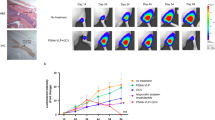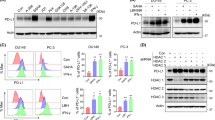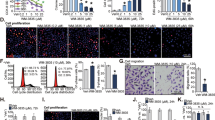Abstract
Tumor necrosis factor–related apoptosis-inducing ligand (TRAIL/Apo2L) has been shown to induce apoptosis in malignant cells without harming normal cells. To determine the antitumor potential of TRAIL against prostate cells, we undertook a comprehensive study that included eight prostate cancer cells lines (CWR22Rv1, Du145, DuPro, JCA-1, LNCaP, PC-3, PPC-1, and TsuPr1) and primary cultures of normal prostate epithelial cells (PrEC). Cells were tested for susceptibility to soluble TRAIL in the presence or absence of the chemotherapeutic agent doxorubicin. TRAIL was also delivered by an adenoviral vector. Our results reveal that Du145, DuPro, LNCap, TsuPr1, and PrEC were resistant to 100 ng/mL TRAIL. JCA-1 and PPC-1 were slightly sensitive (20% killing) and PC-3 and CWR22Rv1 exhibited the highest sensitivity to TRAIL (30% and 50% killing, respectively). The combination of 10 ng/mL TRAIL with doxorubicin resulted in 60–80% cytotoxicity in seven of eight prostate cancer cells. TRAIL-mediated apoptosis involved cleavage of Bid, caspase-3, and PARP, and required caspase-8 and -9 activity. Full-length TRAIL delivered by an adenoviral vector (AdTRAIL-IRES-GFP) killed prostate cancer cell lines and PrEC without requisite doxorubicin cotreatment. Therefore, expression of the transgene from a tissue-specific promotor would make gene therapy with AdTRAIL-IRES-GFP a possibility.
This is a preview of subscription content, access via your institution
Access options
Subscribe to this journal
Receive 12 print issues and online access
$259.00 per year
only $21.58 per issue
Buy this article
- Purchase on Springer Link
- Instant access to full article PDF
Prices may be subject to local taxes which are calculated during checkout









Similar content being viewed by others
References
Greenlee RT, Hill-Harmon MB, Murrey T, Thun M . Cancer Statistics 2001 CA 2001 51: 15–36
Ries LAG, Kosary CL, Hankey BF, Miller BA, Harras A, Edwards BK . SEER Cancer Statistics Review, 1973–1994 National Cancer Institute. NIH Publ. No. 97-2789. Bethesda, MD: US Dept. of Health and Human Services, Public Health Institute, National Institutes of Health, National Cancer Institute 1997
Steiner MS, Gingrich JR . Gene therapy for prostate cancer: where are we now? J Urol 2000 164: 1121–1136
Pitti RM, Marsters SA, Ruppert S, Donahue CJ, Moore A, Ashkenazi A . Induction of apoptosis by Apo-2 ligand, a new member of the tumor necrosis factor cytokine family J Biol Chem 1996 271: 12687–12690
Wiley SR, Schooley K, Smolak PJ et al. Identification and characterization of a new member of the TNF family that induces apoptosis Immunity 1995 3: 673–682
Ashkenazi A, Pai RC, Fong S et al. Safety and antitumor activity of recombinant soluble Apo2 ligand J Clin Invest 1999 104: 155–162
Walczak H, Bouchon A, Stahl H, Krammer PH . Tumor necrosis factor–related apoptosis-inducing ligand retains its apoptosis-inducing capacity on Bcl-2– or Bcl-xL–overexpressing chemotherapy-resistant tumor cells Cancer Res 2000 60: 3051–3057
Jo M, Kim TH, Seol DW et al. Apoptosis induced in normal human hepatocytes by tumor necrosis factor–related apoptosis-inducing ligand Nat Med 2000 6: 564–567
Nitsch R, Bechmann I, Deisz RA et al. Human brain-cell death induced by tumour-necrosis-factor–related apoptosis-inducing ligand (TRAIL) Lancet 2000 356: 827–828
Lawrence D, Shahrokh Z, Marsters S et al. Differential hepatocyte toxicity of recombinant Apo2L/TRAIL versions Nat Med 2001 7: 383–385
Griffith TS, Chin WA, Jackson GC, Lynch DH, Kubin MZ . Intracellular regulation of TRAIL-induced apoptosis in human melanoma cells J Immunol 1998 161: 2833–2840
Kim K, Fisher MJ, Xu SQ, el-Deiry WS . Molecular determinants of response to TRAIL in killing of normal and cancer cells Clin Cancer Res 2000 6: 335–346
Keane MM, Ettenberg SA, Nau MM, Russell EK, Lipkowitz S . Chemotherapy augments TRAIL-induced apoptosis in breast cell lines Cancer Res 1999 59: 734–741
Hernandez A, Wang QD, Schwartz SA, Evers BM . Sensitization of human colon cancer cells to TRAIL-mediated apoptosis J Gastrointest Surg 2001 5: 56–65
Nguyen T, Zhang XD, Hersey P . Relative resistance of fresh isolates of melanoma to tumor necrosis factor–related apoptosis-inducing ligand (TRAIL)-induced apoptosis Clin Cancer Res 2001 7: Suppl S
Nimmanapalli R, Perkins CL, Orlando M, O'Bryan E, Nguyen D, Bhalla KN . Pretreatment with paclitaxel enhances Apo-2 ligand tumor necrosis factor–related apoptosis-inducing ligand-induced apoptosis of prostate cancer cells by inducing death receptors 4 and 5 protein levels Cancer Res 2001 61: 759–763
Bonavida B, Ng CP, Jazirehi A, Schiller G, Mizutani Y . Selectivity of TRAIL-mediated apoptosis of cancer cells and synergy with drugs: the trail to non-toxic cancer therapeutics Int J Oncol 1999 15: 793–802
Nesterov A, Lu XJ, Johnson M, Miller GJ, Ivashchenko Y, Kraft AS . Elevated Akt activity protects the prostate cancer cell line LNCaP from TRAIL-induced apoptosis J Biol Chem 1076 276: 10767–10774
Nagane M, Huang HJS, Cavenee WK . The potential of TRAIL for cancer chemotherapy Apoptosis 2001 6: 191–197
Griffith TS, Anderson RD, Davidson BL, Williams RD, Ratliff TL . Adenoviral-mediated transfer of the TNF-related apoptosis-inducing ligand/Apo-2 ligand gene induces tumor cell apoptosis J Immunol 2000 165: 2886–2894
Kagawa S, He C, Gu J et al. Antitumor activity and bystander effects of the tumor necrosis factor–related apoptosis-inducing ligand (TRAIL) gene Cancer Res 2001 61: 3330–3338
Norris JS, Hyer ML, Voelkel-Johnson C, Lowe SL, Rubinchik S, Dong J-Y . The use of Fas Ligand, TRAIL and Bax in gene therapy of prostate cancer Curr Gene Ther 2001 1: 123–136
Rubinchik S, Ding R, Qiu AJ, Zhang F, Dong J . Adenoviral vector which delivers FasL-GFP fusion protein regulated by the tet-inducible expression system Gene Ther 2000 7: 875–885
Rubinchik S, Lowe S, Jia Z, Norris J, Dong J . Creation of a new transgene cloning site near the right ITR of Ad5 results in reduced enhancer interference with tissue-specific and regulatable promoters Gene Ther 2001 8: 247–253
Strebel A, Harr T, Bachmann F, Wernli M, Erb P . Green fluorescent protein as a novel tool to measure apoptosis and necrosis Cytometry 2001 43: 126–133
Doroshow JH . Anthracyclines and anthracenediones In: Chabner BA, Longo DL, eds Cancer Chemotherapy and Biotherapy Philadelphia: Lippincott-Raven 1996 409–434
Schulze-Osthoff K, Ferrari D, Los M, Wesselborg S, Peter ME . Apoptosis signaling by death receptors Eur J Biochem 1998 254: 439–459
Yu R, Mandlekar S, Ruben S, Ni J, Kong AN . Tumor necrosis factor–related apoptosis-inducing ligand–mediated apoptosis in androgen-independent prostate cancer cells Cancer Res 2000 60: 2384–2389
Liu WH, Bodle E, Chen JY, Gao MX, Rosen GD, Broaddus VC . Tumor necrosis factor–related apoptosis-inducing ligand and chemotherapy cooperate to induce apoptosis in mesothelioma cell lines Am J Respir Cell Mol Biol 2001 25: 111–118
Wajant H, Moosmayer D, Wuest T et al. Differential activation of TRAIL-R1 and -2 by soluble and membrane TRAIL allows selective surface antigen-directed activation of TRAIL-R2 by a soluble TRAIL derivative Oncogene 2001 20: 4101–4106
Gibson SB, Oyer R, Spalding AC, Anderson SM, Johnson GL . Increased expression of death receptors 4 and 5 synergizes the apoptosis response to combined treatment with etoposide and TRAIL Mol Cell Biol 2000 20: 205–212
Nagane M, Pan G, Weddle JJ, Dixit VM, Cavenee WK, Huang HJ . Increased death receptor 5 expression by chemotherapeutic agents in human gliomas causes synergistic cytotoxicity with tumor necrosis factor–related apoptosis-inducing ligand in vitro and in vivo Cancer Res 2000 60: 847–853
Sun SY, Yue P, Lotan R . Implication of multiple mechanisms in apoptosis induced by the synthetic retinoid CD437 in human prostate carcinoma cells Oncogene 2000 19: 4513–4522
Wu GS, Kim K, el-Deiry WS . KILLER/DR5, a novel DNA-damage inducible death receptor gene, links the p53-tumor suppressor to caspase activation and apoptotic death Adv Exp Med Biol 2000 465: 143–151
Wen J, Ramadevi N, Nguyen D, Perkins C, Worthington E, Bhalla K . Antileukemic drugs increase death receptor 5 levels and enhance Apo-2L–induced apoptosis of human acute leukemia cells Blood 2000 96: 3900–3906
Lacour S, Hammann A, Wotawa A, Corcos L, Solary E, Dimanche-Boitrel MT . Anticancer agents sensitize tumor cells to tumor necrosis factor–related apoptosis-inducing ligand-mediated caspase-8 activation and apoptosis Cancer Res 2001 61: 1645–1651
van Bokhoven A, Varella-Garcia M, Korch C, Hessels D, Miller GJ . Widely used prostate carcinoma cell lines share common origins Prostate 2001 47: 36–51
Acknowledgements
The authors thank Dr. Seymon Rubinchik for the construction of the adenoviral vectors and Dr. Margaret Kelly for critical reading of the manuscript. This research was supported by National Institutes of Health (NIH) RO1 CA69596 (to JSN) and Grant #IRG-97-151 from the American Cancer Society (to CV-J).
Author information
Authors and Affiliations
Corresponding author
Rights and permissions
About this article
Cite this article
Voelkel-Johnson, C., King, D. & Norris, J. Resistance of prostate cancer cells to soluble TNF-related apoptosis-inducing ligand (TRAIL/Apo2L) can be overcome by doxorubicin or adenoviral delivery of full-length TRAIL. Cancer Gene Ther 9, 164–172 (2002). https://doi.org/10.1038/sj.cgt.7700420
Received:
Published:
Issue Date:
DOI: https://doi.org/10.1038/sj.cgt.7700420
Keywords
This article is cited by
-
Escaping cell death via TRAIL decoy receptors: a systematic review of their roles and expressions in colorectal cancer
Apoptosis (2022)
-
Cyproterone acetate enhances TRAIL-induced androgen-independent prostate cancer cell apoptosis via up-regulation of death receptor 5
BMC Cancer (2017)
-
Guiding TRAIL to cancer cells through Kv10.1 potassium channel overcomes resistance to doxorubicin
European Biophysics Journal (2016)
-
Antitumor Effect of TRAIL on Oral Squamous Cell Carcinoma using Magnetic Nanoparticle-Mediated Gene Expression
Cell Biochemistry and Biophysics (2014)
-
Adeno-associated virus-mediated doxycycline-regulatable TRAIL expression suppresses growth of human breast carcinoma in nude mice
BMC Cancer (2012)



